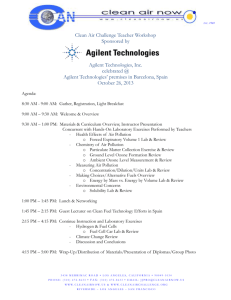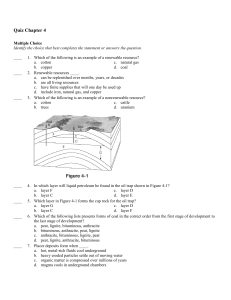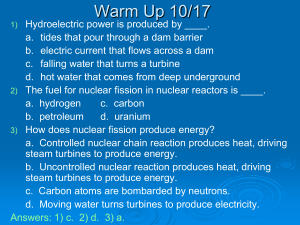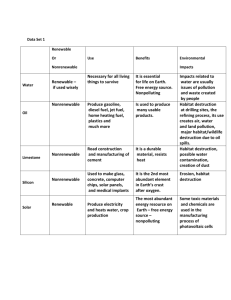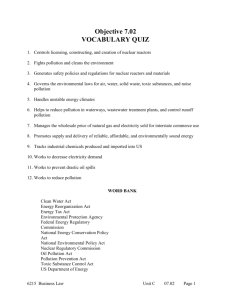Energy Jenga Word
advertisement
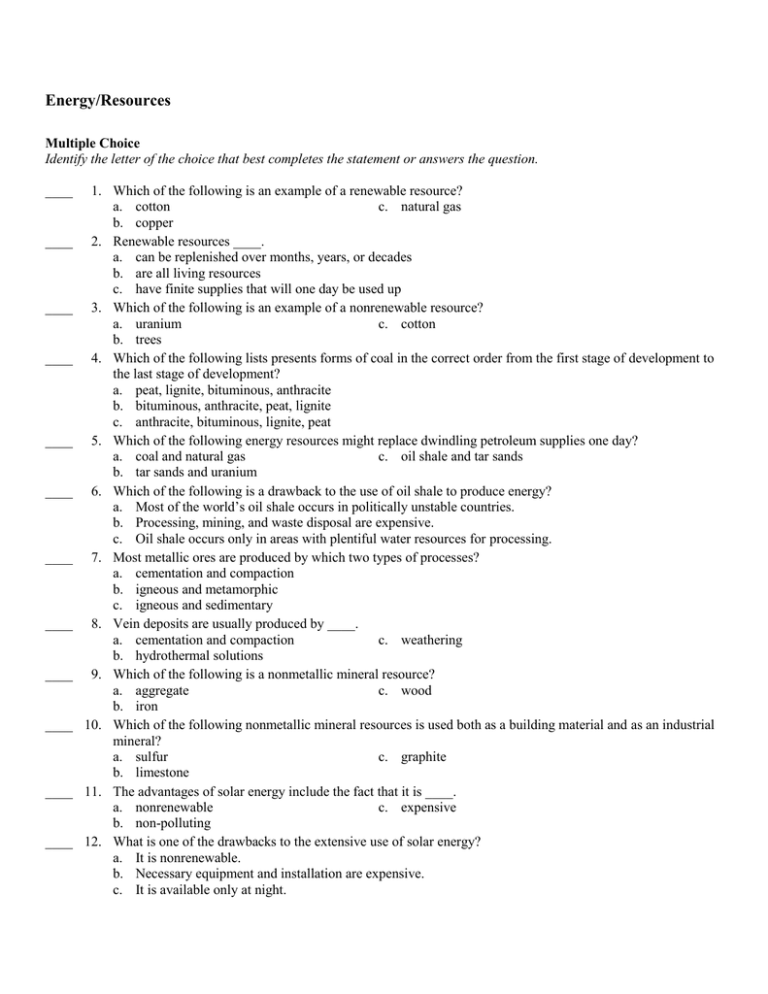
Energy/Resources Multiple Choice Identify the letter of the choice that best completes the statement or answers the question. ____ ____ ____ ____ ____ ____ ____ ____ ____ ____ ____ ____ 1. Which of the following is an example of a renewable resource? a. cotton c. natural gas b. copper 2. Renewable resources ____. a. can be replenished over months, years, or decades b. are all living resources c. have finite supplies that will one day be used up 3. Which of the following is an example of a nonrenewable resource? a. uranium c. cotton b. trees 4. Which of the following lists presents forms of coal in the correct order from the first stage of development to the last stage of development? a. peat, lignite, bituminous, anthracite b. bituminous, anthracite, peat, lignite c. anthracite, bituminous, lignite, peat 5. Which of the following energy resources might replace dwindling petroleum supplies one day? a. coal and natural gas c. oil shale and tar sands b. tar sands and uranium 6. Which of the following is a drawback to the use of oil shale to produce energy? a. Most of the world’s oil shale occurs in politically unstable countries. b. Processing, mining, and waste disposal are expensive. c. Oil shale occurs only in areas with plentiful water resources for processing. 7. Most metallic ores are produced by which two types of processes? a. cementation and compaction b. igneous and metamorphic c. igneous and sedimentary 8. Vein deposits are usually produced by ____. a. cementation and compaction c. weathering b. hydrothermal solutions 9. Which of the following is a nonmetallic mineral resource? a. aggregate c. wood b. iron 10. Which of the following nonmetallic mineral resources is used both as a building material and as an industrial mineral? a. sulfur c. graphite b. limestone 11. The advantages of solar energy include the fact that it is ____. a. nonrenewable c. expensive b. non-polluting 12. What is one of the drawbacks to the extensive use of solar energy? a. It is nonrenewable. b. Necessary equipment and installation are expensive. c. It is available only at night. ____ 13. The fuel for nuclear fission in nuclear reactors is ____. a. uranium c. hydrogen b. petroleum ____ 14. How does nuclear fission produce energy? a. Moving water turns turbines to produce electricity. b. Controlled nuclear chain reaction produces heat, driving steam turbines to produce energy. c. Uncontrolled nuclear reaction produces heat, driving steam turbines to produce energy. ____ 15. It is estimated that, in the future, wind energy could produce what percentage of the nation’s demand for electricity? a. 80–85% c. 70–75% b. 5–10% ____ 16. Wind power generates ____. a. noise pollution c. water pollution b. air pollution ____ 17. Hydroelectric power is produced by ____. a. falling water that turns a turbine b. tides that pour through a dam barrier c. hot water that comes from deep underground ____ 18. What is the source of geothermal energy? a. sunlight heating surface waters b. the splitting of atoms to release energy c. natural underground reservoirs of steam and hot water ____ 19. How is tidal power harnessed? a. by building a dam across a swiftly flowing river b. by bombarding uranium nuclei with neutrons c. by building a dam across the mouth of a bay or an estuary in a coastal area ____ 20. Which of the following is an example of a nonpoint source of fresh water pollution? a. pesticide runoff from farm fields c. sewage treatment plant b. leaking toxic waste landfill ____ 21. What amount of Earth’s total water supply is usable fresh water? a. 25% c. 50% b. less than 1% ____ 22. What is the function of the atmosphere’s ozone layer? a. shields Earth from harmful solar radiation b. provides the oxygen needed by human life c. protects Earth from the sun’s heat ____ 23. Which of the following is NOT a land resource? a. wind c. soil b. iron ____ 24. Which of the following products do petroleum resources provide in addition to energy? a. aggregate c. nickel b. plastic ____ 25. One way that mining for mineral resources damages the land is by ____. a. causing salinization b. depleting the world’s ozone c. increasing soil erosion ____ 26. In which decade were the first important laws passed to decrease water pollution? a. 1950s c. 1970s ____ 27. ____ 28. ____ 29. ____ 30. ____ 31. ____ 32. b. 1960s The Clean Water Act ____. a. set maximum contaminant levels for pollutants in drinking water b. required industries to reduce or eliminate point source pollution in surface waters c. established National Ambient Air Quality Standards Cars with hybrid and electric motors ____. a. use more fuel than conventional cars b. create less air pollution than conventional cars c. use solar panels for power What is the most important law passed to deal with air pollution? a. Clean Water Act b. Resource Conservation and Recovery Act c. Clean Air Act Contour plowing is a soil conservation method that involves ____. a. plowing deeper into soil when planting b. never planting crops on hills c. plowing across hill slopes The Resource Conservation and Recovery Act of 1976 has resulted in ____. a. a decrease in the amount of recycling b. an increase in the use of compost c. a decrease in the illegal and unsafe dumping of hazardous waste Compost helps preserve the health of soil because it ____. a. is a natural fertilizer b. contains pesticides that kill insects c. breaks rock down into additional soil Matching Match each item with the correct statement. a. fission b. chemical energy c. solar energy d. wind power e. hydroelectric energy ____ ____ ____ ____ ____ ____ ____ ____ ____ ____ 33. 34. 35. 36. 37. 38. 39. 40. 41. 42. f. g. h. i. j. biomass gasohol geothermal energy nuclear energy fusion Organic matter that can be a source of energy. The energy produced by heat within Earth. The energy released when a chemical compound reacts to produce new compounds. A process in which the nuclei of radioactive atoms are split. The joining of two or more nuclei to form a larger nucleus. Electrical energy produced by falling water. The use of a windmill to drive an electric generator. The energy received by Earth from the sun in the form of radiation. A mixture of gasoline and alcohol that is used as a fuel. The energy released by a fission or fusion reaction. Match each item with the correct statement. a. fossil fuel e. fusion b. petroleum c. natural gas d. coal ____ ____ ____ ____ ____ ____ 43. 44. 45. 46. 47. 48. f. acid precipitation g. hydrocarbon h. smog Rain, sleet, or snow that contains a high concentration of acids. Photochemical haze that forms when sunlight acts on industrial pollutants and burning fuels. Liquid mixture of complex hydrocarbon compounds used as a fuel source. Nonrenewable energy resource formed from the remains of organisms that lived long ago. Solid fossil fuel that forms from partially decomposed plant material. Gaseous mixture of hydrocarbons used as a fuel.

